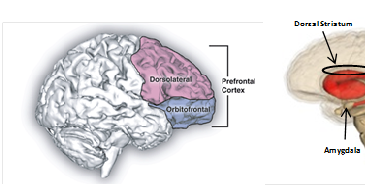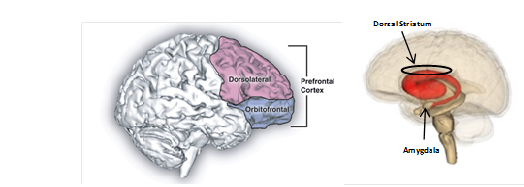Previous studies have identified differences in the processing of risk and reward in pathological gamblers (PG). For example, PGs tend to incorrectly overestimate their chances of winning, and discount their losses (Linnet et al., 2012). The underpinnings of these cognitive distortions remain unknown. This week’s WAGER explores whether these tendencies have a neurobiological origin (van Holst, Veltman, Buchel, van den Brink, & Goudriaan, 2012).
Methods
- Researchers recruited 15 disordered gamblers from Dutch addiction treatment centers and 16 controls through local newspapers. All participants were male.
- Participants completed a questionnaire, including the South Oaks Gambling Screen (SOGS: Lesieur & Blume, 1987) to measure gambling problems.
- Participants completed 192 rounds of a gambling simulation task while in an fMRI machine.
- For each round, participants saw ten face-down cards – nine black cards, and one red ace. Either three or seven cards were highlighted. If one of the highlighted cards was the red ace, the participant would win either €1 or €5, as displayed on the screen.
- Participants indicated whether they expected to win or lose prior to the card reveal.
- During the task, the fMRI machine measured blood flow to various parts of the brain, measuring activation in specific areas of the brain. Researchers focused on three areas in particular, displayed in Figure 1:
- The dorsal striatum (DS) and the orbitofrontal cortex (OFC), which are associated with rewarding stimuli, and reinforce behaviors that lead to gain or expected gain.
- The amygdala, which is associated with aversive stimuli, and discourages behaviors that lead to loss or expected loss.
Figure 1: Location of the orbitofrontal cortex (OFC), dorsal striatum (DS), and amygdala within the brain. Both images obtained from Wikimedia Commons. Second image generated by Life Science Databases(LSDB). [CC-BY-SA-2.1-jp (http://creativecommons.org/licenses/by-sa/2.1/jp/deed.en)].
Results
- There was no main effect of group on outcome expectancy. In other words, PGs did not expect to win more or less often than controls, F (1,29) = 2.27, n.s.
- Researchers found greater activity in the DS (Z = 4.39, p <.05) and OFC (Z = 3.35, p <.05) in PGs compared to controls, when participants expected to win. This means that PGs experienced more activation of their brains’ reward center than controls when they expected to win.
- Researchers found no differences in amygdala activity when participants expected to lose.
- Researchers found a strong negative correlation between SOGS score and amygdala activity when participants expected to win, r = -.76, p <.05. In other words, the more severe a participant’s gambling problems, the less activity that participant showed in the risk-sensitive region of the brain when expecting to win.
Limitations
- The study only included male participants.
- This study is correlational; we cannot conclude whether PG caused the neurological changes, the neurological changes caused PG, or whether a third factor caused both.
- The healthy controls were not necessarily gamblers. Therefore, we do not know whether the differences found between groups relate to PGs in particular, or simply to differences in activation between people with varying levels of gambling experience.
Conclusions
This study provides preliminary evidence that the cognitive distortions that accompany disordered gambling may have neurobiological underpinnings. The results suggest that gambling problems are associated more with brain processes involved in the anticipation of winning (i.e., experiencing more activation of the brain’s reward centers and less activation of the brain’s risk system) than those associated with the anticipation of losing.
– Daniel Tao and Sarah Nelson
What do you think? Please use the comment link below to provide feedback on this article.
Lesieur, H. R., & Blume, S. B. (1987). The South Oaks Gambling Screen (SOGS): A new instrument for the identification of pathological gamblers. American Journal of Psychiatry, 144(9), 1184-1188.
Linnet, J., Froslev, M., Ramsgaard, S., Gebauer, L., Mouridsen, K., & Wohlert, V. (2012). Impaired probability estimation and decision-making in pathological gambling poker players. Journal of Gambling Studies, 28(1), 113-122. doi: 10.1007/s10899-011-9244-2
van Holst, R. J., Veltman, D. J., Buchel, C., van den Brink, W., & Goudriaan, A. E. (2012). Distorted expectancy coding in problem gambling: is the addictive in the anticipation? Biological Psychiatry, 71(8), 741-748.





